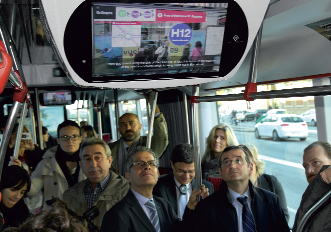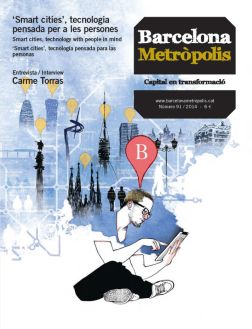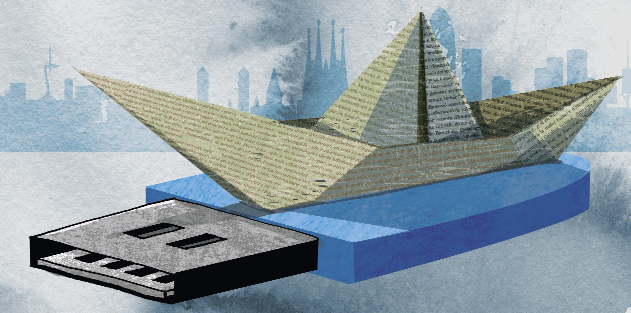The port’s smart dimension is starting to turn every movement into valuable information. It is more than fifteen years since the port of Barcelona first applied the pioneering initiatives that have enabled more efficient and competitive services with reduced environmental impact. Better mobility planning through smart technologies is also one of the current challenges for the metropolitan transport manager.
Each day between 1,500 and 1,800 lorries enter the port of Barcelona terminals to load and unload goods. That means jobs for 20,000 workers. Orchestrating all the operations interwoven in each and every one of these journeys requires a great deal of collective intelligence. Information technologies are key. It is more than fifteen years since Port de Barcelona first applied the pioneering initiatives that have enabled the generation of more efficient and competitive services with reduced environmental impact.
The port’s smart dimension is starting to turn every movement into valuable information. “Capturing movements with sensors is the best way of identifying and integrating them,” explains Catalina Grimalt, the information systems director at Port de Barcelona. When a lorry arrives, a sensor reads the number plate. This seemingly simple operation, which only lasts a second, allows the recovery and integration of all the information about the vehicle. “The Port Community System is a system of intelligent messages that has substituted many of the previous procedures. Operations that took minutes are instantaneous, reducing queues and waiting times, and also, therefore, CO2 emissions,” adds Grimalt.
In the past, all these procedures took a lot of time and paperwork, but the amount spent on paper dropped dramatically some time ago. There is yet another benefit: the cameras that read the number plates are directly connected to the Civil Guard.
The space sensors are also useful for predicting storms. “A system of sensors and algorithms gives a 24-hour warning of any inclement weather. This makes the logistics of moving vessels to other ports much easier, which is especially important from the point of view of safety in the case of cruise ships: if there are going to be strong easterly winds we can dock the cruise liner in a safer place,” explains Grimalt. Each year, 2.6 million cruise passengers pass through the port of Barcelona.
The port also has a system that, by detecting mobile phones, can help collect data on the number of people present and their location. As well as this, they are developing a system to receive signals from the ships that pass through – radar and AIS – to prevent incidents.
The efficiency and savings that this information management is responsible for also translate into increased competitiveness with other ports. “These are services that benefit people and also make us more efficient and competitive,” confirms Jordi Torrent, head of strategy at Port de Barcelona. “Thanks to ICTs we have all kinds of information available that we can then provide to our people. They are indicators that may be useful to suppliers and are incorporated into the Efficiency Network, the quality brand for operators specialised in container goods.”
The ecological footprint
Exporting a container from Geneva, Switzerland, to Jedah, Saudi Arabia, via the port of Barcelona, including overland lorry and rail transport, generates 910 kilograms of CO2 emissions. If this same container travelled through Antwerp, one of ports that competes with Barcelona, the emissions would be much higher: 1.5 tonnes. That means transporting goods through Barcelona results in a 41% saving in CO2 emissions, as well as saving on fuel, obviously.
That calculation is possible thanks to the Ecocalculator, an online tool (www.portdebarcelona.cat/ecocalculadora) that provides exact data on the ecological footprint of any merchandise. It plots the routes on Google Maps and generates a report that makes choosing easier.
Beyond the environmental impact, the tool shows that the port of Barcelona is very competitive and efficient, especially as a gateway to Europe from Asia. Goods from China destined for central Europe take three or four days less by boat if they are unloaded in Barcelona.
TMB’s commitment to personal mobility
Bus stops that interpret the tastes of the waiting public, offer customised advertising and even allow people to make purchases with a smartphone. A place for videoconferencing in metro stations where you can communicate face-to-face with service staff. Apps for planning routes, giving timetables and knowing whether the unexpected has occurred. These are only some of the services that Transports Metropolitans de Barcelona (TMB) is working on as a key part of shaping a smart city. Other services, such as providing real-time information through screens, are already here.

© Vicente Zambrano
Presentation of the bi-articulated hybrid bus for the H12 line at the Smart City Tour of 2013. The bus was one of the first to offer travellers different kinds of information accessible from screens or with QR codes, Wi-Fi service and mobile payment.
Every day close to two million people move around Barcelona on public transport. The importance of transport for the general public is enormous and information is paramount in facilitating their daily movements. “For this reason customer service policies are very important. We are obliged to find solutions,” says Jordi Nicolás, chief executive of the Chair’s Office at TMB, the organisation which, in 2008, developed the first technology master plan. “At that moment the crisis and the emergence of new technologies coincided. We had to reduce communication costs and the introduction of all these measures means that now we spend five times less and we also know, from the surveys we have carried out, that user satisfaction has increased.”
There are teams of professionals dedicated exclusively to managing all of the communication channels. From MouTV (MoveTV), with 1,800 screens, to social networks – 60,000 people follow TMB on Facebook and Twitter – and QR codes. “They are a good tool for collecting and monitoring user feedback,” explains Monica Jimenez, manager of digital information and customer care at TMB. “We believe that in the future much of this information will go through mobile phones, from everything offered by a smartquesina – smart, sustainable bus stops that were presented to great acclaim during the Mobil World Congress – to apps.”
Currently, metro and bus stops already have devices announcing how long a vehicle will be. The mobile apps TMB Maps and TMB Virtual already have more than 300,000 downloads. A big step has even been taken towards creating TMB Open Data, a space to make the city’s transport data available to everyone, particularly professionals working on new technologies. “We are making metro and bus information available to the developers that want to incorporate it into their apps,” points out Nicolás.




